Brownbanded Bamboo Shark
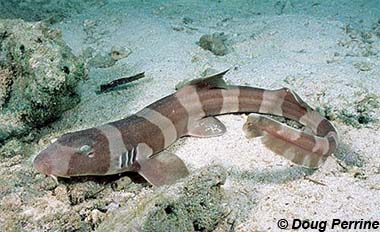
Chiloscyllium punctatum
These elongated, slender carpet sharks have lobed fins and an asymmetrical caudal (tail) fin. The young ones are medium brown with darker brown banding, but that fades to a solid brown as they mature. They live between the shore and the reef on muddy sea floors, where they hunt at night using the sensitive barbels on their snouts to locate crabs, worms, and other small prey. Because they are so hardy, able to survive out of water for several hours at times, they are popular in aquariums.
Order – Orectolobiformes
Family – Hemiscylliidae
Genus – Chiloscyllium
Species – punctatum
Common Names
Common names in the English language include brownbanded bamboo shark, brown spotted cat shark, brown-banded bamboo shark, brown-banded catshark, brown-spotted catshark, grey carpet shark, and spotted catshark. Other common names are bamboa estriada (Spanish), bruinegebande bamboehaai (Dutch), brunbåndet bambushaj (Danish), cá Nhám trúc v?n (Vietnamese), chalarm Gob (Thai), chkuot (Khmer), chlarm (Khmer), gorbeh-kooseh-e-lakkedar (Persian), hiu bodoh (Malay), inu zame (Japanese), inuzame (Japanese), mangiwang peke (Makassarese), mungsing hiu (Malay), pating (Tagalog), requin-chabot bambou (French), yu bodoh (Malay), yu punai (Malay), yu tokeh (Malay), and yu toleh (Malay).
Importance to Humans
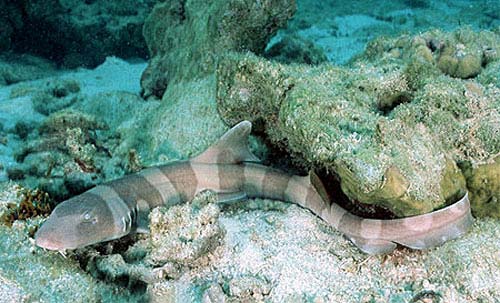
The brownbanded bamboo shark is important to commercial fisheries in the inshore waters of India, Thailand, and perhaps Singapore, Malaysia, and the Philippines where it is utilized for human consumption. In Australia, this shark is often taken in beach seines and on hook and line and is considered good quality for consumption. However, in the remainder of its range of distribution, pressure on this species is also due to habitat loss to destructive fishing methods on reefs as well as collection for the aquarium trade. It is a favorite with home aquarists as well as public aquarium facilities in Australia, Europe, Mexico, Canada, and the United States. This species is able to reproduce in captivity.
Danger to Humans
Considered harmless to humans, the brownbanded bamboo shark may nip divers if provoked.
Conservation
> Check the status of the brownbanded bamboo shark at the IUCN website.
The IUCN is a global union of states, governmental agencies, and non-governmental organizations in a partnership that assesses the conservation status of species.
Due to insufficient data, this species does not meet the criteria to be considered “Vulnerable”. However it is considered “Near Threatened” due to concern over impact of human activities on this species throughout much of its range. Major threats include collection for human consumption and habitat degradation from dynamite and cyanide fishing. Collection for the aquarium trade is considered to be a minor threat since this species is hardy and will breed prolifically in captivity.
Geographical Distribution
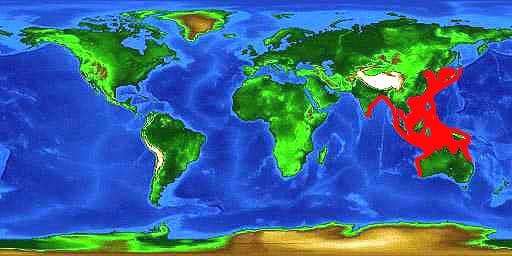
Brownbanded bamboo sharks are distributed in the Indo-West Pacific region including off India, Thailand (along the east coast and the Andaman Islands), Malaysia, Singapore, Indonesia (Java, Sumatra, Sulawesi, and Komodo), Viet Nam, China, Taiwan, Japan, and Philippines. This species is also found off the southern coast of New Guinea (Papua-New Guinea and Iriah Jaya, Indonesia) and northern coast of Australia (Northern Territory, Western Australia, and Queensland).
Habitat
This small tropical shark is commonly found on inshore coral reefs and over sandy and muddy bottom habitats ranging in depth from 0-279 feet (0-85 m). It is a generally solitary animal with small individuals hiding in crevices of the reefs, well camouflaged with their banding pattern. As a nocturnal feeder, this shark becomes more active at night when it excavates the sediments in search of prey. An extremely hardy species, the brownbanded bamboo shark is also often observed in tide pools and can tolerate hypoxia for extended periods of time.
Biology
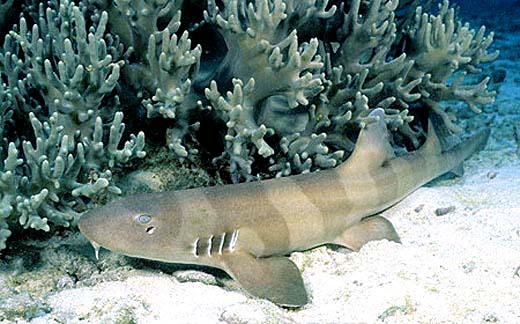
Distinctive Features
The brownbanded bamboo shark has a slender body with an elongated and thick precaudal tail. The mouth is located closer to the eyes than to the rounded tip of the snout. The spiracles are located below and behind the moderately large eyes. Both dorsal fins are approximately of equal size with the origin of the first dorsal fin located opposite the anterior halves of the pelvic fin bases or slightly anterior to the pelvic fin origins. The base of the first dorsal fin is longer than the second dorsal fin base. These spineless dorsal fins are larger than the pelvic fins and have concave posterior margins and elongated free rear tips. The interdorsal space is relatively short. The pectoral fins are straight with very broad tips. The origin of the anal fin is just posterior to the free rear tip of the second dorsal fin. It is long and low, located just posterior to the caudal fin. The caudal fin has a distinct subterminal notch, the ventral lobe is absent. The body lacks a lateral dermal ridge. Predorsal and interdorsal ridges are not prominent.
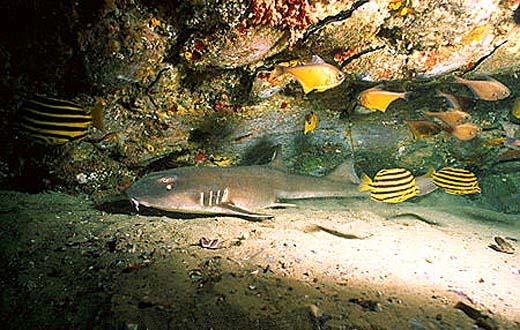
Coloration
Young individuals are distinctly marked with dark transverse bands and scattered dark spots. The adults are light brown and lack any color pattern on the body.
Dentition
The teeth of bamboo sharks (Family: Hemiscylliidae) are not strongly differentiated in the upper and lower jaws. Each tooth has a medial cusp and weak labial root lobes. The number of tooth rows is 26-35/21-32.
Size, Age & Growth
The maximum reported size of the brownbanded bamboo shark is 41 inches (104 cm) total length. Adult males reach sexual maturity at 27-30 inches (68-76 cm) in length, while females mature at 25 inches (63 cm) in length. The life expectancy of the brownbanded bamboo shark is approximately 25 years.
Food Habits
The brownbanded bamboo shark feeds on benthic organisms and small fishes. One study in Australian waters found their diet to consist of crabs, polychaete worms, shrimps, and small fishes.
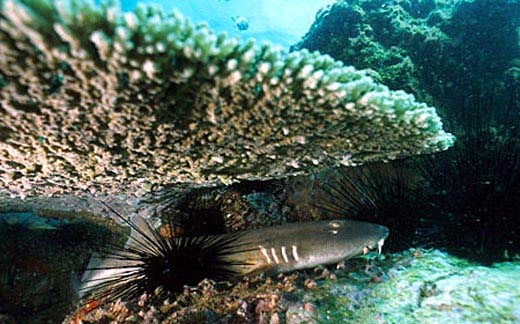
Reproduction
This bambooshark is oviparous. Paired eggs are released into the benthic environment. Measuring 4.3×5.9 inches (11×15 cm), the egg cases is elongated and flattened. The embryos feed entirely on the yolk within the egg case until they hatch and become free-swimming. In captivity, it can take up to four months after being released from the female for hatching to occur. The young bamboo sharks measure 5-7 inches (13-17 cm) total length upon hatching.Predators
Potential predators of the brownbanded bamboo shark include larger fish such as sharks as well as marine mammals.
Parasites
Parasites have been documented from the gills of the brownbanded bamboo shark including the larvae of an isopod Gnathia sp. and a copepod Eudactylina aspera. In recent research, two new species of tapeworms,Yorkeria hilli and Yorkeria kelleyae, have been described from the spiral intestine of a brownbanded bamboo shark collected at a fish market in Thailand.
Taxonomy
The brownbanded bamboo shark was originally described as Chiloscyllium punctatum by Müller & Henle (1838). It is a member of the family Hemiscyllidae which consists of bamboo sharks and carpet sharks. In past scientific literature, this species has been misidentified as Chiloscyllium plagiosum, Chiloscyllium griseum, and Chiloscyllium hasselti. One synonym, Chiloscyllium margaritiferum Bleeker 1863, has been used in reference to the brownbanded bambooshark. The genus name, Chiloscyllium, is derived from the Greek “cheilos” meaning lip and “skylla” defined as a kind of shark.
Prepared by: Cathleen Bester